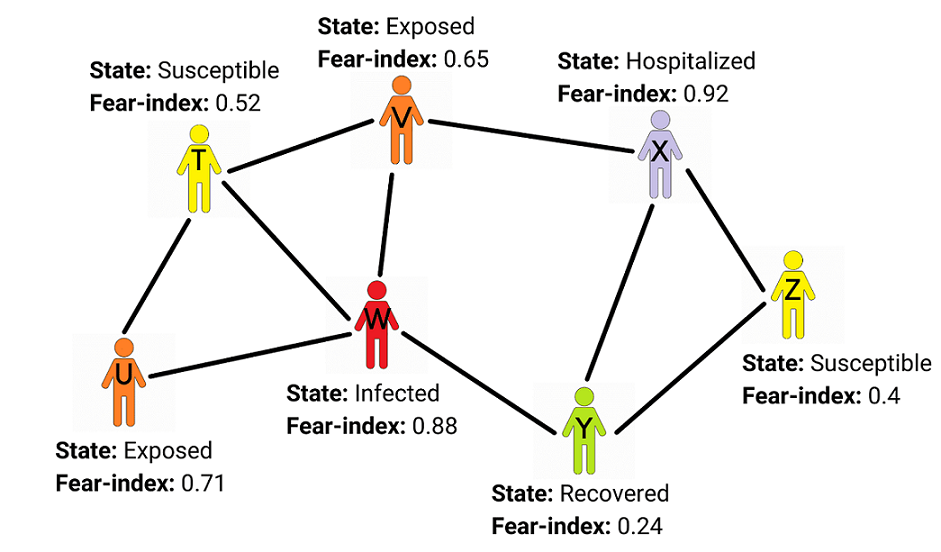What is it about?
Modeling and analyzing the Epidemic Spread Process is a multidisciplinary research area with deep roots in mathematical biology, social sciences, and computer science. With its strong relevance to humanity, epidemiologists worldwide dedicate themselves to devising epidemic models to understand better and predict the spread of infectious diseases. Epidemic models aid in formulating effective strategies for disease control, public health interventions, and decision-making. Classical differential equation-based compartmental models, most commonly used to study the spread of infectious diseases, assume a homogeneous mixing of contact patterns. However, the reality is much more complicated than the simplifying assumptions of these models. Considering the complexities of social interactions and contact patterns, the network-based approach is an alternative to the differential equation-based model. However, in addition to the biology of contagion, disease progression is profoundly influenced by the complex patterns of human connectance, human behavior, and social and cultural practices. The fundamental premise of our research underscores the importance of integrating human behavior and population characteristics into an epidemic model. This integration is vital for effective disease control and developing a realistic disease progression model. Rather than relying solely on theoretical assumptions or idealized scenarios, we parameterize our models with real-world data from diverse sources such as epidemiological studies, census data, and contemporary research papers.
Featured Image

Photo by Markus Spiske on Unsplash
Why is it important?
Our work bridges the gap between mathematical epidemic models and real-world scenarios, where human connectance, individual behavior, and social and cultural factors, significantly impact the epidemic dynamics. The contributions advance the modeling of epidemic spread in contact networks, increasing their utility as tools for guiding public health officials in managing infectious diseases.
Perspectives

The proposed Individual-based Fear Model (IBFM) facilitates the development of tailored intervention strategies to effectively mitigate the spread of infectious diseases across diverse populations and cultures. The extended IBFM provides a realistic representation of fear dynamics at the community level and is useful for developing community-level targeted strategies for epidemic control and public health management. The proposed wire-frame to construct a census-calibrated modular contact network, enriched with geography-specific demography, serves as a powerful tool for studying various scenarios related to disease outbreaks, mobility restrictions, vaccine distribution, and other behavioral dynamics to aid policy planners and administrators in general. The ability to predict epidemic variables using the regression chain model enables public health officials and policymakers to implement proactive measures, such as resource allocation, public awareness campaigns, and targeted interventions, thus minimizing the spread of infectious diseases and reducing the societal impact.
Kirti Jain
Department of Computer Science, University of Delhi, Delhi, India
Read the Original
This page is a summary of: Modeling Behavioral and Epidemic Dynamics in Social Contact Networks, November 2023, ACM (Association for Computing Machinery),
DOI: 10.1145/3625007.3631605.
You can read the full text:
Resources
- Related Content
Coupling Fear and Contagion for Modeling Epidemic Dynamics
The emotion of fear related to an infectious disease not only influences an individual's behavior but also transmits to social contacts. Therefore, modeling human behavior is a precursor to reliable estimates of epidemic size and duration. This paper presents an abstract model of fear, which is realized using an Individual-based Fear Model (IBFM). In this model, fear is coupled with contagion to study the influence of human behavior on epidemic dynamics. Since fear is an inherent characteristic of an individual that determines susceptibility to infection, the model discerns between individuals by maintaining a fear-index. Variations in innate fear levels in populations with cultural differences are also accommodated. Since the fear level of individuals is affected by the changing size of the epidemic, IBFM provides a mechanism to update fear in the population realistically. The mechanism gives rise to multiple epidemic waves observed in real-world epidemics. We compare the epidemic dynamics for IBFM and the differential equation-based realization of the abstract model. We present a detailed empirical study to understand the interplay of fear and contagion in IBFM.
- Related Content
Epidemic dynamics in census-calibrated modular contact network
Network-based models are apt for understanding epidemic dynamics due to their inherent ability to model the heterogeneity of interactions in the contemporary world of intense human connectivity. We propose a framework to create a wire-frame that mimics the social contact network of the population in a geography by lacing it with demographic information. The framework results in a modular network with small-world topology that accommodates density variations and emulates human interactions in family, social, and work spaces. When loaded with suitable economic, social, and urban data shaping patterns of human connectance, the network emerges as a potent decision-making instrument for urban planners, demographers, and social scientists. We employ synthetic networks to experiment in a controlled environment and study the impact of zoning, density variations, and population mobility on the epidemic variables using a variant of the SEIR model. Our results reveal that these demographic factors have a characteristic influence on social contact patterns, manifesting as distinct epidemic dynamics. Subsequently, we present a real-world COVID-19 case study for three Indian states by creating corresponding surrogate social contact networks using available census data. The case study validates that the demography-laced modular contact network reduces errors in the estimates of epidemic variables.
- Related Content
Collective Behavior in Community-Structured Network and Epidemic Dynamics
Contagious diseases spread in population thru the contact network and their spread is a function of the complex interplay of the biological infectivity and behavior of individuals. In this research, we aim to understand how the epidemic dynamics is impacted by the collective behavior of individuals in communities. The stochastic block model is used to generate a community-structured network to investigate the spread of disease using the classical SIR spreading model. We model individual behavior as fear-index that indicates the extent to which an individual follows health and hygiene protocols as a self-protective measure against disease. We observe that the collective behavior of individuals in a community strongly influences the course of an epidemic. Infected individuals with low fear-index rapidly spread the infection within and outside the community. Furthermore, low fear in communities leads to faster growth of the epidemic. We also find that the communities, which comply with the restrictions manifesting high fear level, also suffer the burden of the disease because of non-compliance by other communities (low fear level). Communities with low fear levels are ‘high risk’ groups and should be targeted for awareness campaigns.
- Related Content
Regression Chain Model for Predicting Epidemic Variables
Real-time detection and forecasting of disease dynamics is critical for healthcare authorities during epidemics. In this paper, we report a systematic investigation into the possibility of predicting three epidemic variables, viz., peak day, peak infections, and span of the epidemic using the Regression Chain Model. We construct a dataset, EpiNet, using 35K synthetic networks of varied sizes and belonging to three network families. The dataset consists of five network features and three target variables obtained by simulating the SEIR epidemic model on the networks. We train Regression Chain Model (RCM) using four popular machine learning algorithms to predict the target variables. The model generally performs fairly well for peak day and peak infections, but the performance degrades for the span variable. Our preliminary investigation motivates further inquiry into the use of RCMs to replace computationally expensive epidemic simulations on larger networks.
- Presentation
PhD. Track Presentation, International Conference ASONAM' 2023
Title: Modeling Behavioral and Epidemic Dynamics in Social Contact Networks Authors and Affiliations: 1. Kirti Jain: Department of Computer Science, University of Delhi, Delhi, India 2. Vasudha Bhatnagar: Department of Computer Science, University of Delhi, Delhi, India 3. Sharanjit Kaur: Acharya Narendra Dev College, Department of Computer Science, University of Delhi, Delhi, India Conference: The 2023 IEEE/ACM International Conference on Advances in Social Networks Analysis and Mining (ASONAM). Conference Dates: November 6-9, 2023. Venue: Kusadasi, Turkey.
Contributors
The following have contributed to this page









